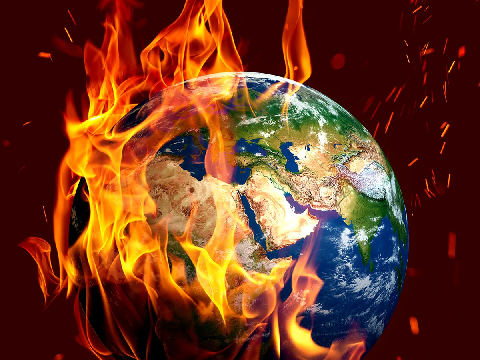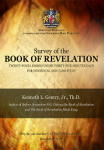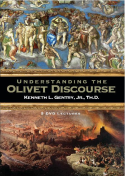NEW CREATION IN 2 PETER 3 (2)
PMW 2025-023 by David Russell
Gentry note: This continues from my previous posting of an insightful section of David Russell’s The “New Heavens and the New Earth” published by Visionary Press. To get the context of this posting, you must read the previous one.
It is difficult, if not impossible, to determine the best reading and its interpretation in the context. While there is strong support for the translation, “will be found” in the sense that humanity’s works “will be laid bare” (NIV), this view nevertheless seems strained. It may reflect the thinking of the scribe who at an early stage introduced the reading but whether or not it represents the reading of the author’s hand is uncertain. The reading has merit since the primary focus of the passage is the judgment upon the wicked. However, this view drives a wedge between humankind and the created order. A solidarity between humanity and the creation is always a basic working assumption whether or not it is expressed. The author’s contemplation of God’s judgment on evil works naturally leads to a consideration of the effects of that judgment upon the created order. Just as the decree upon humanity affected the creation according to Genesis 3 so also will God’s judgment have cosmic consequences. Additionally, verses 10–11 imply that the earth will suffer a similar fate as the heavens. This clearly accounts for the reading of aphanisthesontai. Wolters’ interpretation does not necessarily demand the acceptance of eurethesetai. He could have arrived at the same basic conclusion from the verb katakaesetai (cf. Mal. 4.1). Wolters’ strength is the emphasis upon the OT context, and moreover Bauckham’s conjecture that an apocalyptic source lies behind 2 Peter 3, while plausible, merely affirms the use of traditional motifs. Particularly noteworthy is 1 Enoch 1.6 which as noted above by Metzger also may contain an acceptable solution for the reading.

Survey of the Book of Revelation
(DVDs by Ken Gentry)
Twenty-four careful, down-to-earth lectures provide a basic introduction to and survey of the entire Book of Revelation. Professionally produced lectures of 30-35 minutes length.
See more study materials at: www.KennethGentry.com
And the eternal God will walk upon the earth, on Mount Sinai,… and the high mountains will be shaken and will fall and be dissolved and the high mountains will be made low so that the mountains will waste away [toiu diaruenai] and they will melt like wax before the fire in flame and the earth will be split apart and all the things upon the earth will perish (1 Enoch 6.3-7, translated from G; cf. Ps. 97.5, Zeph. 1.18).
As noted in our discussion of this passage in chapter three, this verse like 2 Peter 3 reflects more appropriately the OT theophanic texts which reveal through violent language God’s authority over his creation rather than total dissolution of the World (cf. Mic. 1.4; Nah. 1.5; Hab. 3.6).
The language of 2 Peter 3 nevertheless has suggested to some the influence of Greek cosmology. As mentioned, the Greeks envisioned world history in two movements each punctuated decisively by the destruction of the world by water and fire. In Plato’s Timaeus a legend is recounted regarding several destructions of humanity of which the greatest are by fire and water and the lesser ones by countless other means (22B-C). Interestingly, the term ekpurosis does not appear and the destruction by fire is described in the same manner as the flood by which the gods “purged” (kathairontes) the earth by water (22D). That the Stoic doctrine of was influential in Judaism even among the more reclusive Qumran sectarians was noted in the discussion of 1QH 3.29-36. In contrast to Jewish conceptions, the Stoic idea was based on an impersonal and mechanical cyclical cosmology in which the cosmos periodically dissolved into fire, its basic element, from which the world was reborn. Each “new” world, however, was identical to the former. The context of Peter’s teaching indicates that the conceptual matrix is found in the OT and Jewish apocalyptic traditions. The distinctiveness of the Jewish and Christian concept of a new creation in contrast to Stoic ideas is thus immediately apparent. As Riesner states, the Stoic expected a neos kosmos while 2 Peter anticipated a kainos ouranos kai ge kaine. The uniqueness is likewise evident in the hope of the new creation as the basis of ethical admonitions (v. 11). The worldview of the writer is therefore that of Jewish Christianity.
Understanding the Olivet Discourse 
By Ken Gentry
This 5 DVD lecture set was filmed at a Bible Conference in Florida. It explains the entire Olivet Discourse in Matt. 24–25 from the (orthodox) preterist perspective. This lecture series begins by carefully analyzing Matt. 24:3, which establishes the two-part structure of the Discourse. It shows that the first section of the Discourse (Matt. 24:4–35) deals with the coming destruction of the temple and Jerusalem in AD 70. This important prophetic event is also theologically linked to the Final Judgment at the end of history, toward which AD 70 is a distant pointer.
For more educational materials: www. KennethGentry.com
Whatever conclusions may be drawn from the passage regarding creation and cosmic hope, one must realize that 2 Peter 3 is first and foremost a text concerning the certain punishment of the wicked and reward for the righteous. The cosmic scope the destruction no doubt communicated to the scoffers not only the reality of judgment but that nothing or no one could escape the wrath of God. Furthermore, the anticipation of the day of the Lord functioned primarily to encourage righteous living in preparation for the “new heavens and new earth in which righteousness dwells” (vv. 13, 14). In this regard, Peter’s hesitancy to describe the new creation in vivid and picturesque detail betrays the NT concern more for who is coming rather than what is to come. 198 This statement, however, does not diminish the importance of the new creation for the who of the eschaton will be no other than the creator God.
The passage nevertheless reveals important information regarding the concept of the future of creation. The heavy barrage of words such as apoleias, apolesthai (vv. 7, 9), pur, puroumenoi (vv. 7, 12), kriseos (v. 7), luo (vv. 10, 243 11, 12), kausoumena (vv. 10, 12), and teketai (v. 12) reveal the violence of the devastation. An ultraliteral reading of such language, however, fails to recognize that Peter portrays the advent of God in typical theophanic language reflecting the terrible effects of God’s wrath upon the wicked that even will reach cosmic proportions. Nonetheless, this picture discloses a radical discontinuity between the old and the new world more than any other passage previously encountered in this study of the OT or NT. However, that the passage rejects the idea of total annihilation is evident from the author’s typological hermeneutic. The flood motif as a type of future judgment and deliverance for humanity and creation suggests that the author does not envision total destruction and a new creation ex nihilo, but as in God’s first intervention there will be a purging primarily related to sinful humanity. Further, a total and final desolation of the creation not only implies a Gnostic view which denigrates the present created order but also denies the redemptive aspect even in the judgment of God. Judgment is not the last word; it is merely the prelude to the new heavens and new earth. Notably, the overwhelming influence of the OT in 2 Peter 3, as a glance at the NA reveals, makes it clear that Peter does not depart from the OT hope of a new creation which especially in Isaiah 65 reflects a continuity with the old creation.
2 Peter thus speaks of a radical discontinuity and continuity. The old world purged from corruption through the refining fires of God has given way to a new order. This hope of the new heavens and new earth rejects Käsemann’s assertion that 2 Peter evinces “the relapse of Christianity into Hellenistic dualism.” According to Käsemann, the writer stands apart from the Pauline doctrine of redemption “in a materialist sense.” 2 Peter reflects the believer’s longing for escape from the corruption of this world and the attainment of his ultimate destiny, namely, the participation in the divine phusis — apotheosis (cf. 1.4). On the contrary, the writer of 2 Peter has not altered the Pauline doctrine of redemption which includes all creation. Peter has no disdain for this world. He, like the other apocalyptists has a concern for the present created order. The “materialist” promise of the new heavens and new earth is opposed to a dualistic escape from the present world to another eternal, ethereal existence. 2 Peter 3 is entirely in accord with Paul’s concept of the freedom of creation (Rom. 8.21). In fact, although this passage represents a more radical break with the old world than does Romans 8, Beker’s statement with reference to Paul applies also to 2 Peter for both writers draw upon the same biblical and apocalyptic worldview that renounces the Gnostic contempt for this world and affirms the importance of the created order. God will not negate his creation. As Beker notes:
“Although the glory of God will break into our fallen world, it will not annihilate the world but only break its present structure of death, because it aims to transform the cosmos rather than to confirm its ontological nothingness.” (emphasis by Russell).
GOODBIRTH AND THE TWO AGES
I am currently researching a technical study on the concept of the Two Ages in Scripture. This study is not only important for understanding the proper biblical concept of the structure of redemptive history. But it is also absolutely essential for fully grasping the significance of the Disciples’ questions in Matthew 24:3, which spark the Olivet Discourse. This book will be the forerunner to a fuller commentary on the Olivet Discourse in Matthew’s comprehensive presentation. This issue must be dealt with before one can seriously delve into the Discourse itself.
If you would like to support me in my research, I invite you to consider giving a tax-deductible contribution to my research and writing ministry: GoodBirth Ministries. Your help is much appreciated! https://www.paypal.com/donate/?cmd=_s-xclick&hosted_button_id=4XXFLGKEQU48C&ssrt=1740411591428
Kenneth L. Gentry Jr.'s Blog
- Kenneth L. Gentry Jr.'s profile
- 85 followers



